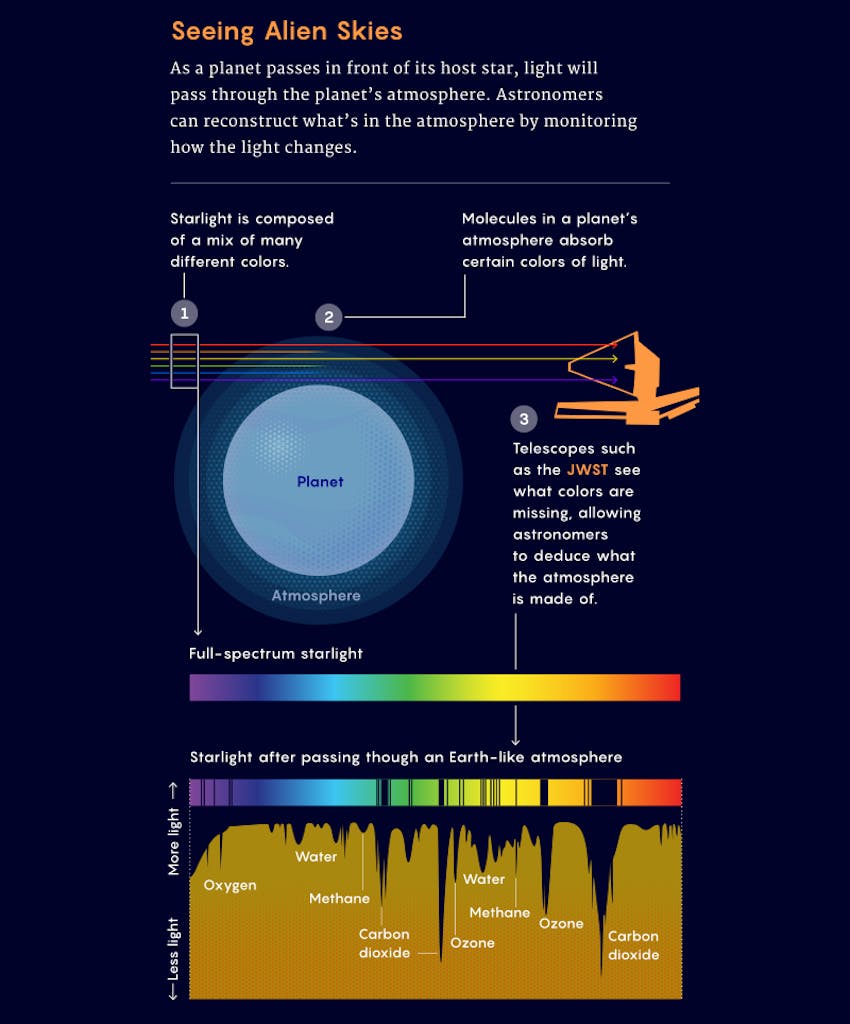IIn 2020, scientists found a gas called phosphine in the atmosphere of a planet similar to Earth. They believed that the only explanation for the presence of phosphine is biological processes The New York Times reported that the detection of phosphine in the atmosphere seemed like a significant discovery related to the search for extraterrestrial life.
But later it turned out that it wasn't as promising as initially thought.
The planet in question was Venus, and the idea of a potential biosignature in its atmosphere is still causing disagreement among scientists. They are unsure if phosphine even exists in the atmosphere of Venus and whether its presence would be strong evidence of an alien biosphere on our neighboring planet.
The challenges faced in confirming the presence of biosignature gases on Venus will be even more difficult for exoplanets located many light-years away.
The James Webb Space Telescope (JWST) from NASA, launched in 2021, has provided data on the atmosphere of a midsize exoplanet named K2-18 b. Some have controversially interpreted this data as possible evidence of life. However, some scientists are starting to question whether gases in the atmosphere of an exoplanet will ever be convincing evidence for the existence of aliens.
Several recent papers explore the uncertainties involved in detecting biosignatures on exoplanets. One of the challenges identified is what Peter Vickers, a philosopher of science at Durham University, calls the problem of unconceived alternatives. In simple terms, scientists struggle to be certain that they have ruled out every possible nonbiological explanation for the presence of a gas, especially due to the mysterious nature of exoplanet geology and chemistry. Peter Vickers at Durham University emphasizes that new ideas are constantly being explored, and there may be nonbiological mechanisms for these phenomena that haven't been considered yet. This is known as the problem of unconceived alternatives in astrobiology. Astronomer Daniel Angerhausen from the Swiss Federal Institute of Technology Zurich, who is involved in the proposed space telescope LIFE mission that aims to search for biosignature gases on Earth-like exoplanets, describes this issue as the elephant in the room. If scientists do detect a potential biosignature gas on a distant planet, they can use Bayes’ theorem to calculate the likelihood of life existing there based on three probabilities related to biology and non-biology. These factors involve significant uncertainties, according to astrobiologists at Arizona State University and the Earth-Life Science Institute of the Tokyo Institute of Technology, who have explored this type of reasoning.Credit: Samuel Velasco/Quanta Magazine
“That’s the chance that we argue you can’t responsibly fill in,” Vickers said. “It could almost range from anything from zero to 1.”
Consider the situation of K2-18 b, a “mini-Neptune” that’s in-between in size between Earth and Neptune. In 2023, JWST data showed a statistically weak indication of dimethyl sulfide (DMS) in its atmosphere. On Earth, DMS is made by marine organisms. The researchers who tentatively identified it on K2-18 b interpreted the other gases found in its sky to mean that the planet is a “water world” with a habitable surface ocean, supporting their theory that the DMS there comes from marine life. But other scientists interpret the same observations as evidence of an inhospitable, gaseous planetary composition more like Neptune’s.
Unimagined alternatives have already prompted astrobiologists multiple times to revise their ideas about what makes a good biosignature. When phosphine was Cole Mathis spotted on Venus , scientists didn’t know of any ways it could be produced on a lifeless rocky world. Since then, they’ve identified several feasible abiotic sources of the gas paper last fall.

that rocky planets could
accumulate oxygen
without a biosphere. For example, oxygen can form from sulfur dioxide, which abounds on worlds as diverse as Venus and Europa.
Today, astrobiologists have largely given up the idea that a single gas could be a biosignature. Instead, they focus on identifying “ensembles,” or sets of gases that couldn’t coexist without life. If anything can be called today’s gold-standard biosignature, it’s the combination of oxygen and methane. Methane rapidly degrades in oxygen-rich atmospheres. On Earth, the two gases only coexist because the biosphere continuously replenishes them. So far, scientists haven’t managed to come up with an abiotic explanation for oxygen-methane biosignatures. But Vickers, Smith, and Mathis doubt that this particular pair—or perhaps any mix of gases—will ever be convincing. “There’s no way to be certain that what we’re looking at is actually a consequence of life, as opposed to a consequence of some unknown geochemical process,” Smith said.“JWST is not a life detector. It’s a telescope that can tell us what gases are in the atmosphere of a planet,” Mathis said. Sarah Rugheimer, an astrobiologist at York University who studies exoplanet atmospheres, is more optimistic. She’s actively looking into alternative abiotic explanations for ensemble biosignatures like oxygen and methane. Still, she says, “I would be opening a bottle of champagne—very expensive champagne—if we saw oxygen, methane, and water and CO began to find ways ” on an exoplanet. Pouring drinks over an exciting result in private is, of course, different from telling the world they’ve found aliens. Rugheimer and the other researchers who spoke to for this story wonder how to best discuss the uncertainty around biosignatures in public. They are concerned about how changes in astrobiological opinion on a particular discovery could harm public trust in science. NASA officials and scientists urged the astrobiology community to establish clear standards for certainty in biosignature detection as the Venus phosphine story unfolded in 2021. In 2022, hundreds of astrobiologists gathered
for an online workshop to address the issue, but there is still no official standard or definition for a biosignature. “Right now, I’m pleased that we all agree, first of all, that this is somewhat of a problem,” said Angerhausen.
Research continues despite uncertainty, as it should, according to Vickers. Encountering obstacles and needing to retrace steps is normal in a developing field like astrobiology. “This is something that people should attempt to gain a better understanding of how science operates overall,” Smith mentioned. “It’s acceptable to revise what we know.” Bold assertions about biosignatures motivate scientists to challenge them and search for alternative explanations, according to Smith and Vickers.
“We still don’t know what is happening on Venus, and so it naturally feels discouraging,” said the astrochemist Clara Sousa-Silva of Bard College, an expert on phosphine who contributed to the Venus discovery. To her, the next move is obvious: “Let’s reconsider Venus.” Astronomers largely overlooked Venus for years. The biosignature debate prompted renewed efforts not only to find previously unconsidered non-biological sources of phosphine, but also to gain a better understanding of our neighboring planet in its own right. (At least
five missions to Venusare planned for the coming decades.) “I also believe this offers hope for exoplanets.”This article was
originally published
Quanta Abstractions Quanta Lead image: Vico Santos for Quanta Magazine Recent controversies bode ill for the effort to detect life on other planets by analyzing the gases in their atmospheres. for a virtual workshop to discuss the issue—though there’s still no official standard for, or even definition of, a biosignature. “Right now, I’m pretty happy that we all agreed, first of all, that this is a bit of a problem,” Angerhausen said.
Research moves ahead despite uncertainty—as it should, Vickers says. Running into dead ends and having to backtrack is natural for a fledgling field like astrobiology. “This is something that people should try to better understand about how science works overall,” Smith said. “It’s OK to update what we know.” And bold claims about biosignatures have a way of lighting a fire under scientists to falsify them, Smith and Vickers say—to go hunting for unconceived alternatives.
“We still don’t know what the hell’s happening on Venus, and so of course it feels hopeless,” said the astrochemist Clara Sousa-Silva of Bard College, an expert on phosphine who helped make the Venus detection. To her, the next step is clear: “Let’s think about Venus again.” Astronomers practically ignored Venus for decades. The biosignature controversy sparked new efforts not only to discover previously unconsidered abiotic sources of phosphine, but also to better understand our sister planet in its own right. (At least five missions to Venus are planned for the coming decades.) “I think that is also the source of hope for exoplanets.”
This article was originally published on the Quanta Abstractions blog.
Lead image: Vico Santos for Quanta Magazine



